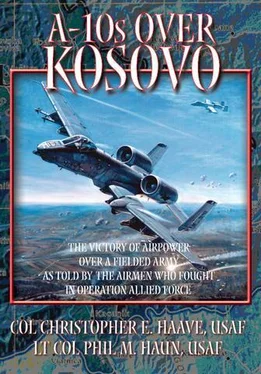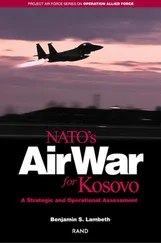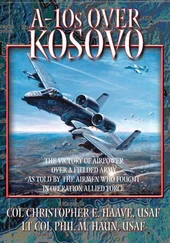The missions flown by A-10 units in Operation Allied Force and the way they developed and evolved over time are described in more detail in the beginning of chapter 2. Lt Col Goldie Haun also provides a detailed look at the history of attacking fielded forces during the period that followed Vietnam through the operations in Kosovo (see appendix). Air Force Doctrine Document 2-1.3, Counterland, provides definitive, up-to-date descriptions of these missions.
The CAS mission is principally characterized by the aircrew’s detailed coordination and integration with the “supported” ground units, and the attack of targets in “close” proximity to those friendly troops. CAS is the classic mission celebrated in movies when threatened troops “call for air.” Soon after the call, aircraft attack the menacing enemy while under the firm control of an airborne or ground forward air controller (FAC) and within view of the friendly soldiers. CAS is high-intensity combat operations made difficult by the unacceptable possibility of fratricide, and all A-10 units regularly practice it. Air Warrior I exercises at Nellis Air Force Base (AFB), Nevada, focus on supporting large ground-unit maneuvers, while Air Warrior II exercises at Barksdale AFB, Louisiana, concentrate on low-intensity combat and are often conducted in urban settings.
CAS can be flown during the day or at night and at low or medium altitudes. Since CAS is a direct fire-support mission for ground maneuver, supporting those ground forces in what they are attempting to accomplish becomes the key factor in determining how to employ the A-10.
During Operation Allied Force there was no CAS tasking since there were no friendly ground troops engaged in hostilities. At the end of the conflict and as a precaution, A-10s were assigned airborne and ground-alert CAS missions for several weeks as the North Atlantic Treaty Organization (NATO) deployed ground forces into Kosovo.
Air interdiction, according to Department of Defense (DOD) and NATO documents, is the use of air operations to destroy, neutralize, or delay the enemy’s military potential (enemy forces, combat support, logistics, and infrastructure) before it can engage friendly forces; the airpower is employed at such distance from friendly forces that detailed integration of each air mission sortie with the fire and movement of friendly forces is not required. During the Cold War, NATO doctrine clearly distinguished between deep interdiction against fixed targets such as bridges and fuel depots, and battlefield air interdiction (BAI) against second-echelon mobile forces. These definitions and the Cold War environment led to broad corporate agreement on which aircraft would be appropriate to use in various roles and on specific types of targets. Even today, long after the end of the Cold War and the significant changes in the nature of potential enemy threats, many military and civilian observers hold outdated, stereotypical views on interdiction. For example, many analysts still argue that F-15Es should only be used to attack bridges and radar sites deep in enemy territory and that A-10s should be limited to attacking tanks close to friendly forces. Current Air Force doctrine recognizes that many factors (e.g., threats, targets, terrain, weather, and political considerations) must be considered when deciding how to best employ airpower in the interdiction mission. The selection of the right asset to achieve specific interdiction objectives cannot be preordained but must be the result of careful analysis.
Almost all OAF missions in Kosovo were AI, or in support of AI, since enemy ground forces were never engaged against friendly ground forces. As we will see, a wide range of aircraft—A-10s, AV-8Bs, F-15Es, B-52s, and numerous other NATO aircraft—successfully attacked mobile and fixed Serb targets in and around Kosovo.
Airborne Forward Air Control
Forward air control is the generic term for the direction of offensive-air-support missions in close proximity to friendly ground troops. The term forward control is opposed to rear control, which refers to the coordination of air strikes by either a ground-based air support operations center or an EC-130E airborne battlefield command and control center (ABCCC). The person directing the air strikes, the FAC, can be deployed with the ground forces or in an aircraft as an AFAC or FAC[A]. Joint documents have adopted the acronym FAC(A), although many Air Force unit instruction manuals have used and still use AFAC. No matter what they are called or where they are located, the FAC is the final clearance authority for an attacking pilot to expend weapons near friendly forces.
Controlling OAF air strikes in the absence of friendly ground forces did not meet the current definition of CAS by either joint or Air Force (AF) doctrine. The latter defines killer scouts as attack aircraft used for AI in an armed reconnaissance role to validate and mark targets for dedicated attack missions against lucrative targets in a specified geographic zone—pretty much the role we had in OAF. The A-10 community, however, has for years used air strike control (ASC) to describe directing aircraft strikes under any circumstance. I will avoid any further discussion of these definitions because I believe that what we did in OAF was FACing in the classical sense. An inaccurate bomb dropped on targets in Kosovo would have had such a severe, negative impact on the coalition’s unity and commitment that FACs in the classical role were required to ensure positive target identification, control attacking aircraft, and prevent inadvertent attacks on innocent civilians. In Kosovo, innocent civilians were in close proximity to the enemy, and for all practical considerations, these missions took on the same urgency and significance as CAS. The airmen who directed and flew these sorties kept their doctrinal terms simple and consistently referred to the control of any air strike as FACing and the pilots as FACs or AFACs. The authors will follow that convention throughout this book.
Traditionally, flying an AFAC mission is like being a traffic cop in the sky. The first duty of the AFAC is to know the ground situation in detail, including the ground commander’s intended scheme of maneuver and objectives throughout the day’s battle. Prior to takeoff, AFACs study the target areas, the types of fighter aircraft they will control on those targets, and the munitions those aircraft will bring to the fight. Once airborne, the AFAC checks in with E-3 airborne warning and control system (AWACS) and ABCCC controllers to get updates on the air and ground situation and starts adjusting the game plan. Nearing the target area—if appropriate—he contacts the ground FAC and organizes the list of targets with the strike aircraft on the way. If armed with appropriate ordnance, the AFAC can begin attacking targets while waiting for the strikers. The AFAC authenticates the strikers when they arrive, using a challenge-and-response code to confirm their identity and preclude the enemy’s use of tactical deception. He then updates the strikers on the target area and passes a standardized target-attack briefing. That briefing includes target type, coordinates, timing factors, weapons to employ, threats relative to the target location, and restrictions on the attack heading (to ensure that no friendly forces, noncombatants, sensitive areas, or structures are damaged by the fighter’s ordnance).
After all this preparation and coordination, the attack finally begins with the AFAC getting the strikers’ “eyes on target” by using visual descriptions, “marking” the target with ordnance, or both. The AFAC usually fires rockets with a white phosphorous charge, known as a “Willy Pete,” that blooms on impact to mark the target. However, he can use anything, such as an exploding bomb or a burning vehicle that had been previously attacked, that will help focus the fight lead’s eyes on the target. After the flight lead confirms the target location, the AFAC clears the flight to expend ordnance on the target, repeating any heading or other attack restrictions. The AFAC watches the fighters and the target area throughout the attack to provide visual warning for enemy surface-to-air fire and to ensure that the fighters really are following the attack heading required and are aiming at the right target. If in doubt, the AFAC can terminate the fighters’ attack by using the abort code passed in the formatted brief.
Читать дальше












